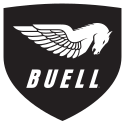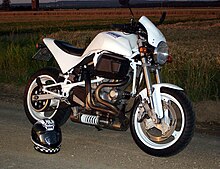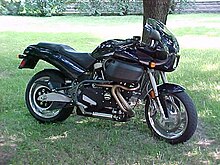Buell
| Buell Motorcycle Company
|
|
|---|---|
| legal form | Corporation |
| founding | 1993 |
| resolution | 2009 |
| Seat | East Troy , United States |
| management | Jon Flickinger, Erik Buell |
| Branch | motorcycles |
| Website | www.buell.com |
The Buell Motorcycle Company (pronounced: bju: l ) was a motorcycle manufacturer with headquarters in East Troy , Wisconsin ( USA ). On October 15, 2009, the owner Harley-Davidson surprisingly announced the end of motorcycle production.
In September 2013, Erik Buell announced that it would start building sports bikes in series again from 2014, but under the EBR label .
General
Buell emerged in 1993 with the participation of the Harley-Davidson Motor Company from the small business founded in 1983 by Erik Buell, a former racing driver who had previously worked for Harley-Davidson as a development engineer for some time. Since February 1998, Harley-Davidson held the majority of the company shares with 98 percent, before the two percent remaining with Erik Buell were bought in 2003. Erik Buell was chairman and chief technical officer (head of development) responsible for design, testing and quality; the President and Chief Operating Officer , Jon Flickinger, was responsible for manufacturing, sales and marketing. On October 15, 2009, Erik Buell announced the end of series production of Buell brand motorcycles on the company's website. Production ended on October 30, 2009. Erik Buell then left Harley-Davidson and founded Erik Buell Racing . Under license from Harley-Davidson, it produces pure racing motorcycles based on the 1125R and sells racing accessories for XB and 1125 models. In October 2013, EBR presented the 1190RX as a roadworthy sports motorcycle and announced that it will sell this and other models from 2014.
Company philosophy
Buell produced sporty motorcycles and naked bikes with mostly high-performance engines from Harley-Davidson. The three constructive basic principles of the company's founder Erik Buell are:
- Centralization of the masses : grouping as many heavy components as possible close to the center of gravity in the center of the vehicle.
- Maximization of the frame and chassis rigidity : torsion-resistant unit consisting of telescopic fork, frame and swing arm for a track-stable chassis.
- Minimization of the unsprung mass : lightweight rims and braking systems for better handling.
Models
Most Buell models are powered by a two-cylinder, V, four-stroke engine. Exceptions are, on the one hand, the Buell RW 750, a pure racing motorcycle with a square four two-stroke engine that was initially produced in extremely small numbers , and the entry-level model Buell Blast with a 492 cc single-cylinder four-stroke engine introduced in 2000 and available in the USA until 2009 .
The models that were created in the early days of the Buell company or were only produced in small numbers are:
- RW 750
- RR 1000 Battletwin
- RR 1200 Battletwin
- RS 1200 west wind
- RS 1200/5 west wind
- RSS 1200 west wind
The so-called tubular frame models were built up to and including model year 2002. In the same model year, the first model in the XB series (also called tank frame models) was launched on the market.
Tubular frame models
Common to all models of this series is the lattice frame, open at the bottom, made of chrome - molybdenum steel tubing, which is connected to the unit consisting of the engine, gearbox and rear swing arm in a vibration-damped manner. While the rear swing arm is mounted in the engine and transmission housing and is therefore not influenced by the drive forces, the entire unit is elastically screwed to the frame via three rubber elements. One of the elements sits below the steering head , the other two on the left and right side at the level of the swing arm mounting. The directional stability of the chassis is ensured by three pendulum supports , via which the engine and gear unit are connected to the frame. These "tie bars" of the so-called "isoplanar" suspension allow the engine to move in the vertical plane of the motorcycle, but not across it. A similar construction principle was used in the Norton Commando as early as 1967, where it was referred to as the "Isolastic" suspension. A more powerful version of the engine from the Harley-Davidson Sportster series with 1,200 cm³, a two-cylinder V-engine with a 45 ° cylinder angle and dry sump lubrication, was used in all tubular frame models. The primary drive to the five-speed gearbox is via a triple roller chain, the secondary drive via a toothed belt. The models differed mainly in the type of fairing and the mixture preparation, and different front forks were used:
- S2 / S2T Thunderbolt (carburetor)
- S1 Lightning (uncovered, carburetor, upside-down fork )
- S1 White Lightning (uncovered, carburetor, upside-down fork)
- S3 / S3T Thunderbolt (half-shell fairing, carburetor, upside-down fork)
- M2 Cyclone (uncovered, carburetor, standard telescopic fork )
- X1 Lightning (uncovered, injection system, upside-down fork)
All models of this series have in common the quite fragile engine - especially a shearing pinion on the oil pump, which results in immediate total engine damage.
XB models
In 2002, Buell ushered in a new era in the company's history with the XB model range. As with the previous Buell motorcycles, the three basic design principles were implemented here - but to a much more consistent degree. In addition, as many components as possible should do more than one job. As a result, the frame, now made of light metal profiles, serves as a fuel tank and the rear swing arm as a reservoir for the oil supply for the dry sump lubrication. For the first time in the history of motorcycle construction, Buell used a Z ero T orsional L oad called a Z ero T orsional L oad as standard, which was attached to the outside of the rim . With this design, the braking forces act directly on the rim without exerting torsional forces on the wheel spokes. This allows the use of particularly light alloy wheels, which significantly reduces the unsprung mass . The rear silencer that is typical of Buell motorcycles and is attached under the engine can also be found here.
The toothed belt drive , which has been tried and tested at Harley-Davidson and Buell, was provided with an additional deflection roller at the level of the swing arm axis, which ensures constant tension of the toothed belt regardless of the deflection movements of the rear swing arm . The advantages of toothed belts over drive chains - smoothness, low maintenance, low weight, elimination of play in the drive train - are thus increased even further. Retensioning is not necessary, so the adjustment mechanism for the rear wheel axle is not required.
The main component of the XB chassis is a light metal bridge frame made of large-volume hollow profiles, the cavities of which are used as a fuel tank. The fuel is therefore much deeper and more central than in a motorcycle with a conventional tank, which shifts the overall center of gravity downwards and reduces the moment of inertia around the longitudinal and transverse axes. In addition, the XB models have the Uniplanar engine suspension patented by Buell, which on the one hand uses the engine as a load-bearing element to increase the frame rigidity, and on the other hand uses rubber elements to keep the concept-related strong engine vibrations almost completely away from the driver during driving.
The rear swing arm is also made of light metal. The left, hollow swing arm and the area around the swing arm serve as an oil tank for dry sump lubrication . This not only reduced the number of components and the weight of the motorcycle, but also created space for the starter battery in a particularly favorable position under the driver's seat.
A fully adjustable upside-down fork at the front and a fully adjustable central spring strut at the rear, which is mounted directly between the frame and swing arm without deflection and which makes the unusually short wheelbase possible thanks to its diagonal position, take care of the suspension and damping.
The XB series is powered by a light, air / oil-cooled 45 ° V2 engine with 984 cm³ for the XB9 or 1203 cm³ for the XB12 and electronic intake manifold injection . This is still largely based on the "Evo-Sportster" engine from Harley-Davidson, but many components have been revised. The increase in displacement of the 12 variant results exclusively from a 17.44 mm longer stroke. The throttle valve and manifold diameters were enlarged to allow for the higher gas throughput. Both engine variants have additional cooling for the pistons by injecting engine oil under the piston crowns. In addition, the external oil cooler in conjunction with a cooling fan mounted behind the second cylinder and the control unit ensure that the engine does not overheat.
It is not yet possible to make a final statement about the durability of the engines, a major problem with the old tubular frame models. However, the XB engines are thermally healthy, the comparatively little engine damage is almost exclusively due to broken drive pinions of the oil pump and damage to the crankshaft bearing . Buell countered the first problem in the 2006 model year with a drive pinion made of a copper - beryllium alloy, from 2008 a completely modified oil pump unit was introduced into series production, and the crankshaft bearing was also reinforced.
The XB models owe their agile handling despite the high engine flywheel mass to an extreme chassis geometry for series motorcycles with a steep steering head angle of 69 °, short caster of 84 mm and a compact wheelbase of only 1320 mm. 52 percent of the comparatively low vehicle weight (ready to drive 205 kilograms) is on the front wheel. However, the unusual chassis geometry also ensures that the XB models are very sensitive to chassis settings and tires. When braking in an inclined position, for example, the Dunlop series tires installed up to the 2006 model year showed a significant righting moment, which is significantly lower with most approved tires from other manufacturers. Buell responded to the criticism for the 2007 model year and has now equipped its motorcycles with Pirelli tires .
The general build quality has been significantly improved compared to the tubular frame models and is on par with most of the competition. However, weaknesses can be seen in the details (improperly laid cables, corrosive rear silencers and various screws).
variants
Type XB1
- Firebolt XB9R
- Lightning XB9S
- Lightning CityX XB9SX (from MY 2010: Lightning XB9SX / XB12SX)
- Lightning XB12SX
- Firebolt XB12R
- Lightning XB12S
- Lightning Low XB12Scg
Type XB2 in comparison to type XB1 has a different, longer frame, longer swing arm, with 66.2 ° or 66.5 ° flatter steering head angle and greater caster
- Lightning Long XB12Ss
- Lightning Super TT XB12STT
- Ulysses XB12X
- Ulysses XB12XT
1125 models
With the Superbike 1125R presented in July 2007 , Buell once again treaded a new path after the introduction of the XB series. For the first time, a liquid-cooled V2 engine with overhead camshafts and four-valve cylinder heads is used. The engine was developed from scratch according to Buell specifications together with BRP-Rotax and was produced there exclusively for Buell. The engine called Helicon has the following key data:
- Liquid-cooled 72 ° V2 four-stroke engine with dry sump lubrication
- DOHC , camshaft drive via self-adjusting timing chain at the inlet and gear at the outlet
- four hollow-bored valves per cylinder operated by rocker arms
- Bore × stroke: 103.0 × 67.5 mm
- Displacement: 1,124.9 cm³
- Compression: 12.3: 1
- maximum output: 109 kW (148 hp) at 9,800 rpm
- maximum torque: 111 Nm at 8,000 rpm
- electronic fuel injection DDFI III with two 61 mm throttle bodies and two 6-hole injection nozzles per cylinder
- Ignition via separate ignition coils integrated in the spark plug connector
- Ram Air pressure charging
- 6 speed transmission
- hydraulically operated multi-plate oil bath clutch with anti-hopping function
The final drive takes place on the left-hand side via a typical Buell toothed belt, in which, as with the XB, a pulley ensures constant tension.
The concept of the newly designed chassis is similar to that of the XB series. Here, too, the aluminum bridge frame also serves as a fuel tank, the rear suspension strut is supported, lying almost horizontally, directly on the cantilever rocker and frame. At the front, a new torsionally rigid upside-down telescopic fork from the manufacturer Showa with 47 mm thick dip tubes takes over the suspension / damping. The spring elements are adjustable in terms of spring base, rebound and compression damping. While the steering head angle (69 °) and caster (84 mm) correspond to the XB series, the wheelbase is slightly longer at 1387 mm.
The 375-millimeter single-disc perimeter front brake known from the XB is equipped with an 8-piston brake caliper on the 1125R, while the lightweight rear brake, which is attached directly to the inside of the swing arm, consists of a 240 mm brake disc and a double-piston brake caliper.
The 1125CR (the CR stands for Cafe Racer ) introduced for the 2009 model year differs from the 1125R in a few details; Instead of the front fairing, it has a lamp mask and instead of the handlebars, it has either an M or a superbike handlebar. In addition, the swing arm and thus the wheelbase is 14 mm longer, and the final ratio is shorter.
Special models
- XBRR (Production Race Bike based on XB with air / oil-cooled 1340 cm³ V2 engine, approx. 110 kW nominal power)
- 1125RR (racing version of the 1125R available from Buell Racing according to AMA - Superbike regulations)
Individual evidence
Picture gallery
Web links
literature
- Buell Book - History / Conversions / Racing / Tuning , Dr. Heinrich Christmann / Carsten Heil / Jens Krüper / Vladimir Marianov / Norman Werner, Huber Verlag (2008), ISBN 978-3-927896-22-2
- Type compass Harley-Davidson / Buell , Matthias Gerst, Motorbuch Verlag (2005), ISBN 3-613-02542-6











